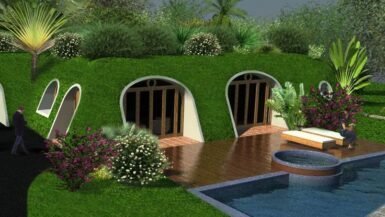Natural light plays a crucial role in creating a comfortable, healthy, and sustainable living environment, especially when it comes to tiny home design. In this article, we will explore various design strategies and architectural elements that can help you maximize the natural light in your tiny home, thereby reducing energy consumption, enhancing its aesthetic appeal, and promoting overall well-being. From innovative window placements and reflective surfaces to open-plan concepts and skylight installations, we will delve into practical solutions for transforming your small living space into a bright and energy-efficient sanctuary. Join us as we shed light on the importance of natural illumination and its potential to revolutionize the way we approach sustainable tiny home design.
Implementing Large Windows and Skylights for Ample Sunlight
When it comes to maximizing natural light in your tiny home, one of the most effective strategies is to incorporate large windows and skylights into your design. These architectural features not only allow sunlight to flood your space but also provide a sense of openness and connection to the outdoors. In this section, we will delve into the advantages of large windows and skylights, as well as offer some practical tips on how to optimize their placement and size.
Benefits of Large Windows and Skylights
Large windows and skylights offer a myriad of benefits that contribute to a sustainable and comfortable living environment. Firstly, they help reduce energy consumption by minimizing the need for artificial lighting during the day. Additionally, they can aid in passive solar heating during colder months, cutting down on heating costs. Moreover, natural sunlight has been proven to boost mood and productivity, contributing to a healthier and more enjoyable living experience.
Optimizing Window Placement
To make the most of natural light, it is essential to consider the orientation of your tiny home when deciding on window placement. South-facing windows will receive the most sunlight throughout the day, while north-facing windows will offer consistent, diffused light. East and west-facing windows can provide morning and evening light, respectively, but may also result in unwanted heat gain during summer months. Positioning windows on multiple sides of your home can also ensure a more balanced distribution of light.
Choosing the Right Size and Type of Windows
When selecting windows for your tiny home, it’s important to strike a balance between size and energy efficiency. Larger windows may provide more natural light, but they can also lead to greater heat loss or gain. To mitigate this issue, opt for energy-efficient windows with double or triple glazing, low-emissivity (low-E) coatings, or insulated frames. Furthermore, consider incorporating a variety of window types, such as casement or awning windows, to facilitate natural ventilation while still allowing ample sunlight.
Integrating Skylights for Elevated Illumination
Skylights can be a game-changer when it comes to enhancing natural light in compact spaces. They not only bring in additional sunlight but also create a sense of spaciousness by drawing the eye upward. However, it’s crucial to select energy-efficient skylight models and ensure proper installation to prevent heat loss and potential leaks. Additionally, consider features like built-in shades or tinted glass to control the amount of light and heat entering your home.
By thoughtfully incorporating large windows and skylights into your tiny home design, you can create a bright, airy, and sustainable living environment that takes full advantage of the sun’s natural illumination.
Utilizing Light-Reflecting Materials and Colors in Interior Design
Another essential aspect of maximizing natural light in your tiny home design is the clever use of light-reflecting materials and colors in your interior design. By incorporating surfaces and hues that efficiently bounce light around your space, you can create an illusion of a larger, brighter, and airier environment. In this section, we will discuss various ways to integrate reflective elements and color schemes that effectively enhance the natural light in your tiny home.
Choosing the Right Color Palette
Colors play a significant role in determining the perceived brightness of a space. Lighter shades, such as white, cream, or pastel colors, can amplify the effect of natural light by reflecting it throughout the room. On the other hand, darker colors tend to absorb light, making a space appear smaller and dimmer. Opting for a lighter color palette for your walls, ceilings, and floors will not only make your tiny home feel more spacious but also help maximize the available natural light.
Integrating Reflective Surfaces and Materials
Incorporating reflective surfaces and materials into your interior design can be a powerful tool for enhancing natural light. Mirrors, glass, and glossy finishes on furniture or cabinetry can effectively bounce light around your space, creating a brighter and more dynamic atmosphere. For instance, installing a mirror opposite a window can double the amount of light entering your room, while glass or mirrored furniture can contribute to the overall sense of spaciousness.
Opting for Light-Enhancing Flooring Options
The choice of flooring material can also impact the amount of natural light in your tiny home. Light-colored and reflective flooring options, such as light wood, polished concrete, or white tiles, can help bounce light upwards and throughout your space. Additionally, consider using area rugs in lighter shades to further improve the light distribution within your tiny home.
Maximizing Light with Clever Furniture Selection
When selecting furniture for your tiny home, consider pieces with lighter colors, reflective surfaces, or transparent materials to optimize the flow of natural light. Glass or acrylic coffee tables, for example, can create a sense of openness while allowing light to pass through unobstructed. Similarly, opting for furniture with reflective or metallic finishes can amplify the natural light in your space.
By carefully considering the colors, materials, and finishes used in your tiny home’s interior design, you can greatly enhance the effect of natural light and create a brighter, more welcoming living environment. These strategies, combined with the thoughtful placement of windows and skylights, can transform your tiny home into a sustainable, energy-efficient, and visually appealing sanctuary.
Strategically Placing Mirrors to Enhance Natural Illumination
Mirrors can be a powerful tool for maximizing natural light in your tiny home design, helping to create a brighter and more spacious environment. In this section, we will explore various strategies for strategically placing mirrors throughout your space to effectively amplify the available sunlight, improve the overall ambiance, and complement your home’s aesthetic. From choosing the right mirror size and style to finding the perfect location, we will provide practical tips on how to harness the full potential of mirrors in enhancing natural illumination.
Finding the Ideal Mirror Size and Style
When selecting mirrors for your tiny home, it’s important to consider both their size and style. Larger mirrors can reflect more light and create a more significant impact, while smaller mirrors can be used to accent specific areas or add visual interest. Additionally, consider the mirror’s frame and style to ensure it complements your interior design. Opt for sleek, minimalist frames or frameless mirrors for a modern look, or choose decorative, ornate frames for a touch of classic elegance.
Placing Mirrors Opposite Windows
One of the most effective ways to enhance natural light using mirrors is to place them directly opposite windows. This allows the mirror to capture and reflect the incoming sunlight, effectively doubling the amount of light in your space. Furthermore, this placement can create a beautiful visual effect, making the room appear larger and more open.
Utilizing Mirrors in Dark Corners and Narrow Spaces
Dark corners and narrow spaces can be transformed with the strategic use of mirrors. Placing a mirror in these areas can help to bounce light around, brightening up the space and making it feel more inviting. Additionally, mirrors can create the illusion of depth in narrow spaces, making them appear wider and more spacious.
Integrating Mirrors into Furniture and Decor
Incorporating mirrors into your furniture and decor can be another effective way to enhance natural light in your tiny home. Consider choosing furniture pieces with mirrored or reflective surfaces, such as a mirrored coffee table, dresser, or sideboard. Alternatively, you can use decorative mirrors as wall art, creating a visually striking display while also improving the light distribution in your space.
Experimenting with Mirror Groupings and Compositions
Lastly, don’t be afraid to get creative with your mirror placements. Experiment with grouping mirrors of different sizes and shapes for a unique and eye-catching focal point. You can also create a gallery wall of mirrors or arrange them in a symmetrical composition for a more structured look. The key is to find a balance between functionality and aesthetics, ensuring that your mirror arrangement not only enhances natural light but also complements your interior design.
By thoughtfully incorporating mirrors into your tiny home design, you can effectively amplify the available natural light and create a brighter, more spacious, and inviting living environment. With the right mirror placements and a keen eye for design, you can transform your tiny home into a well-lit, energy-efficient, and visually appealing sanctuary.
Open-Concept Living Spaces for Unobstructed Light Flow
Incorporating open-concept living spaces in your tiny home design can significantly contribute to the flow of natural light throughout your home, creating a brighter and more welcoming atmosphere. By minimizing walls and barriers, open-concept layouts allow sunlight to travel freely, enhancing the overall sense of spaciousness and connection to the outdoors. In this subsection, we will discuss the benefits of open-concept living spaces in tiny homes, along with practical tips and design considerations to ensure optimal light flow and functionality.
The Advantages of Open-Concept Living Spaces
Open-concept living spaces offer numerous benefits, particularly when it comes to maximizing natural light in tiny homes. These benefits include:
1. Improved light distribution: By eliminating walls and partitions, open-concept layouts allow sunlight to flow unobstructed throughout your home, creating a brighter and more inviting atmosphere.
2. Enhanced sense of spaciousness: Open-concept living spaces can make your tiny home feel larger and more open, helping to alleviate any feelings of confinement often associated with compact living.
3. Better indoor-outdoor connection: Open-concept designs can help to strengthen the connection between your indoor living spaces and the outdoors, allowing you to enjoy the benefits of natural light and views even more.
Designing Functional Open-Concept Living Spaces
While open-concept living spaces can greatly enhance the flow of natural light in your tiny home, it’s crucial to ensure that they remain functional and practical for everyday living. Here are some tips and design considerations to bear in mind:
1. Define zones with furniture: Use furniture to delineate different functional areas within your open-concept space, such as a sofa to separate the living area from the dining or kitchen area.
2. Consider storage solutions: Open-concept living spaces can sometimes lack storage options compared to more traditional layouts. Be sure to incorporate built-in storage, multifunctional furniture, or other creative storage solutions to keep your tiny home organized and clutter-free.
3. Maintain visual cohesion: To create a harmonious and cohesive design, choose a consistent color palette and design style that unifies the different areas within your open-concept living space.
Integrating Flexible and Multifunctional Spaces
To further maximize the benefits of natural light in your open-concept tiny home, consider integrating flexible and multifunctional spaces that can adapt to your changing needs. For example, you might incorporate a fold-out dining table that can be easily stored away when not in use, or a murphy bed that doubles as a work desk during the day. By incorporating such versatile design elements, you can ensure your open-concept living space remains functional and efficient while still promoting optimal light flow.
By embracing open-concept living spaces in your tiny home design, you can create an inviting and well-lit environment that not only maximizes natural light but also enhances the overall sense of spaciousness and connection to the outdoors. With careful planning and thoughtful design choices, an open-concept tiny home can provide a bright, functional, and sustainable living space that truly feels like a sanctuary.
Choosing the Right Window Treatments to Optimize Daylight
Selecting the appropriate window treatments is a crucial aspect of maximizing natural light in your tiny home design. The right window coverings can help control the amount of light entering your space, improve privacy, and enhance the overall aesthetic appeal of your home. In this subsection, we will explore various window treatment options that can optimize daylight in your tiny home, along with practical tips for choosing the perfect solution to complement your design style and functional needs.
Opting for Light-Filtering Shades and Blinds
Light-filtering shades and blinds are an excellent choice for those looking to optimize daylight in their tiny home while maintaining a sense of privacy. These window treatments allow natural light to pass through while still offering some degree of privacy, making them ideal for living spaces and bedrooms. Examples of light-filtering shades and blinds include cellular shades, solar shades, and sheer roller blinds. When selecting these window treatments, be sure to consider factors such as the level of light control and privacy you require, as well as the overall design style of your home.
Choosing Transparent or Translucent Curtains
Transparent or translucent curtains can also be an effective way to maximize natural light in your tiny home. These lightweight fabric options, such as sheer or voile curtains, allow sunlight to filter through while providing a soft, diffused glow. They can be used alone or layered with heavier drapes for added privacy and light control. When choosing transparent or translucent curtains, consider factors such as color, fabric type, and pattern to ensure they complement your interior design and contribute to a bright and welcoming atmosphere.
Exploring Dual-Function Window Treatments
Dual-function window treatments, such as day-night shades or combination blinds, offer the flexibility of both light-filtering and room-darkening options in a single product. These versatile window coverings can be adjusted to allow varying degrees of light control and privacy, making them a practical and efficient solution for optimizing daylight in your tiny home. When selecting dual-function window treatments, look for options that seamlessly blend with your interior design and provide the desired level of light control and privacy.
Considering Customized Window Treatment Solutions
Customized window treatments can be a worthwhile investment when it comes to maximizing natural light in your tiny home design. By opting for custom solutions, you can ensure the perfect fit and functionality for your specific window sizes and shapes. Custom window treatments can also be tailored to meet your unique design preferences and light control requirements, making them a highly personalized option for optimizing daylight in your tiny home.
Keeping Energy Efficiency in Mind
Lastly, it’s essential to consider the energy efficiency of your chosen window treatments. Energy-efficient window coverings, such as insulated cellular shades or thermal curtains, can help regulate indoor temperatures by reducing heat gain or loss, ultimately contributing to a more sustainable and energy-efficient tiny home design. When selecting window treatments, be sure to weigh the benefits of energy efficiency alongside factors such as aesthetics, light control, and privacy.
By carefully considering the various window treatment options available and selecting the best solution to suit your needs, you can effectively optimize daylight in your tiny home design. The right window treatments not only enhance the flow of natural light but also contribute to a comfortable, private, and energy-efficient living environment that truly feels like a sanctuary.





Leave a reply